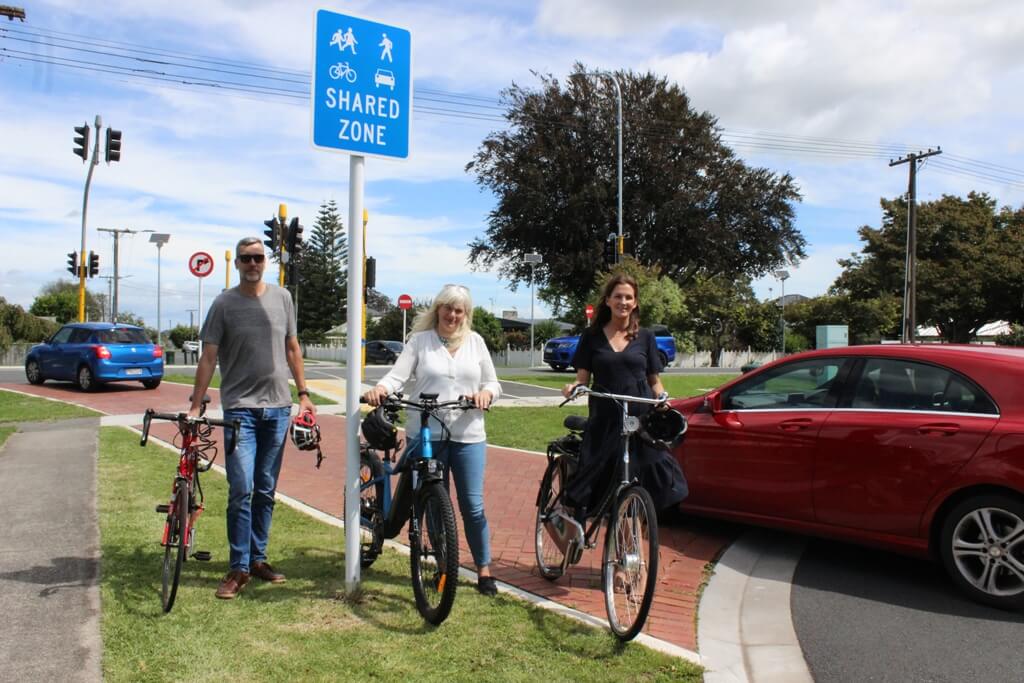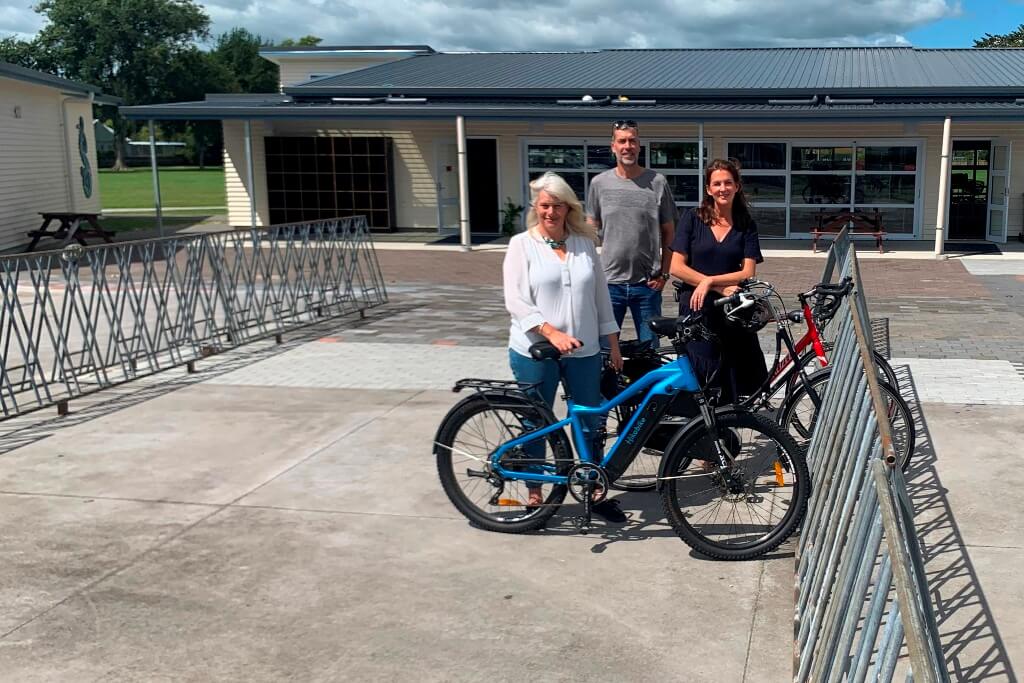
Safe space? Waipā Transportation programme engineer Erik Van Der Wel, left, with deputy mayor Liz Stolwyk, centre, and community board chair Jo Davies-Colley. Photo: Mary Anne Gill
Erik Van Der Wel is part of a team at the forefront of getting Waipā residents out of their cars and onto a network where they can safely walk, bike or scooter.
The $10.9 million to build a district-wide Urban Mobility Network over the next eight years is already underway and will start ramping up soon on both sides of the district. (see council release below)
Van Der Wel, the Transportation programme engineer, joined deputy mayor Liz Stolwyk and Cambridge Community Board chair Jo Davies-Colley to show The News the start of a safe route from the town which will eventually connect to the Te Awa Cycle way at St Peter’s School west of Cambridge.
To say the project has been mired in controversy is an understatement. It started with the experimental ‘Streets for People’ with its polka dots and pink traffic sticks and on the way resulted in the closure of a popular dairy in Grey Street as the street was sealed off to accommodate the first stage of the two-way Hamilton Road Cycleway.
Stolwyk and Van Der Wel both conceded there were parts of those projects that were not well communicated.
And as we stop for a photo in a Shared Zone space at the northern intersection of Grey Street and Hamilton Road – the through route to Cambridge Middle School which has seen a huge increase in cycling and scooter numbers since ‘Streets for People’ – the communication confusion is obvious as cars assume control of the space.
Explaining what a Shared Zone space is to all users is a priority as these spaces will form part of the future network.

Numbers on the up: The cycle racks minutes before this photo was taken were full of bikes because of Waipā’s efforts to make streets safe, says deputy mayor Liz Stolwyk at front of community board chair Jo Davies-Colley and Waipā Transportation programme engineer Erik Van Der Wel. Photo: Mary Anne Gill
“We know most people want fewer cars on our roads and safe pathways for mobility scooters, e-scooters and walkers,” Stolwyk said last year when the government announced Waipā would get up to $10.4 million from its Climate Emergency Relief Fund.
That money will go on two projects – a linked pedestrian and cycleway connecting Kihikihi Town Centre with the primary school and domain – and the protected pathways in Cambridge West taking in the new housing opposite Te Awa Village.
Stolwyk chairs a governance group which meets regularly to establish a shortlist of priority options for the network on both sides of the district.
Its next job next month will be to develop short list options from the project team’s strategic case.
The council will seek further community input at in-person drop in sessions and an online Zoom webinar.
Davies-Colley has three children who cycle regularly to and from school and she often accompanies them.
She is aware of the issues all road users experience and wants to ensure the community is involved.
The same is true in Te Awamutu and Kihikihi where the community board there is taking an active interest in the network which will eventually link the two communities together.
Work speeds up on safe cycleways, walkways
20 February 2023 – Work is about to go up a gear on plans for safer walking and cycling pathways in Kihikihi and Cambridge.
In December, the government announced Waipā District Council would receive up to $10.4 million to help build safer pathways, on top of Council’s contribution. All up around $8.6 million will be spent in Cambridge and around $7.2 million in Kihikihi.
The government money is part of Waka Kotahi’s programme aimed at helping create more transport choices across New Zealand and helping people safely opt out of cars.
Deputy mayor and Urban Mobility Group chair Liz Stolwyk said the government funding had already saved Waipā ratepayers millions. It had allowed the Kihikihi project to be extended to include the full length of Whitmore St plus a connection to the central business area. In Cambridge, it allowed a connection to Cambridge Middle School.
But importantly, the funding boost means Council can move quickly to deliver on key projects which already have strong community support, Stolwyk said.
“The proposed routes in Kihikihi and Cambridge are not new. They’ve been talked about extensively and agreed with Community Boards. There’s also been huge input from community representatives on the Urban Mobility Group including some direct input from schools,” she said.
“We’re at the stage now where we are getting into the nitty-gritty and we need people involved in a constructive way so we can get on with it.”
In Cambridge, the pathway will start on Grey Street outside Cambridge Middle School, and connect with Hamilton Road cycleway. The Hamilton Road cycleway will be extended along Bryce Street to Duke Street. It is proposed to continue along Wilson Street until Victoria Bridge, with an additional pathway on Alpha Street to connect to Te Awa Cycleway and the new pathway.
In Kihikihi, the strong focus for the pathway – named Te Ara Rimu – is on local primary school students with a safe, shared pathway planned for Rolleston, Whitmore and Oliver Streets. Work in Kihikihi is likely to involve intersection changes with possible cul de sacs, a signalised pedestrian crossing, bus stop and roundabout.
Community consultation on the routes will begin later this month with face-to-face presentations, an online Zoom webinar and an online survey. Letters are being hand-delivered to residents on affected streets and everybody would be encouraged to ask questions and provide feedback.
“People who don’t walk or cycle need to appreciate that a growing number of people do, or certainly would do if there were safer options,” Stolwyk said. “And the more people who do, the less cars will be our local roads. We all win from that.”
Following community feedback, plans will be finalised and formally approved in May this year. Works should begin in July 2023 and be complete by early 2024.
To find out more and have a say about plans for Cambridge:
In person, Tuesday March 7, Cambridge Council office, 4pm- 6pm
Online (Zoom webinar), Wednesday March 8, 7-8pm (register at www.waipadc.govt.nz/cambridgepathways)
Fill in a survey www.waipadc.govt.nz/cambridgepathways
To find out more and have a say about plans for Kihikihi
In person, Monday February 27, Kihikihi Town Hall 5.30pm – 8pm
Fill in a survey at www.waipadc.govt.nz/kihikihipathways








